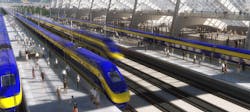High Speed Rail Turns Toward the Bay Area
In a major development for the Bay Area, the California High Speed Rail Authority has released a draft business plan that proposes to connect the Central Valley segment (now under construction) to the Bay Area's Silicon Valley as the next phase of work on the statewide system, MTC executive director Steve Heminger reported to the MTC Commission this week. "The new segment would branch off north of Fresno, enter the region through the Pacheco Pass, and stop at a station in Gilroy on its way to the intermodal hub at Diridon Station in downtown San Jose. The draft plan states that the Authority can finance the Silicon Valley segment with funds already under its control, including the continuous appropriation of Cap and Trade revenue approved by the California Legislature two years ago," Heminger stated in his February Executive Director's Report. The Commission will take a more in depth look at the proposal at thePlanning Committee meeting on March 11, 2016.
More than 100 miles of active construction in the Central Valley is already underway. Earlier sequencing plans called for bringing the high-speed rail line south toward Los Angeles before reaching north to the Bay Area. Under the revised construction sequence, the Authority will complete the construction of the high-speed rail line between Silicon Valley and Central Valley by 2024, with passsenger service operations beginning in 2025. When it is completed, it will run from San Francisco to the Los Angeles basin in under three hours at speeds capable of exceeding 200 miles per hour. The system will eventually extend to Sacramento and San Diego, totaling 800 miles with up to 24 stations.
The draft business plan also calls for a "one-seat ride" between San Francisco and Bakersfield, noting that this goal will require the completion of the Caltrain modernization program/electrification project along the Peninsula to allow the eventual operation of high-speed rail trains in the Caltrain corridor.
"The implications of the Silicon Valley to Central Valley connection are tremendous," the draft business plan states. "With this new connection, a trip from Fresno to San Jose will take about an hour on high-speed rail which is a game changer both for the people and the economy of the Central Valley and for Silicon Valley as well."
